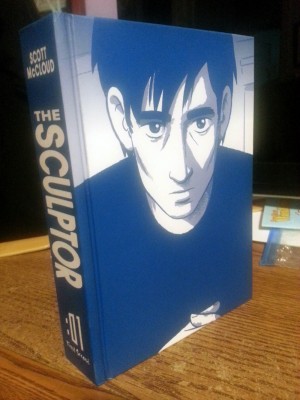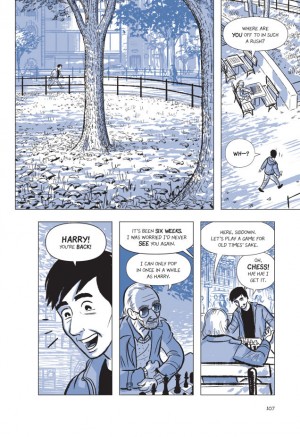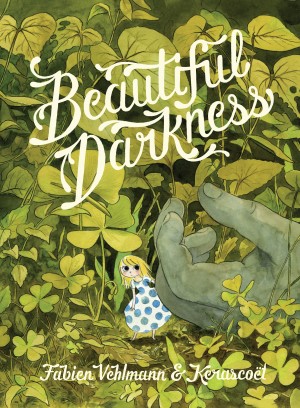Click here for part two: Curveball and Nimona
Click here for part three: Crossed + One Hundred and Stand Still, Stay Silent
Click here for part four: Summary post, including a list of notable sff graphic novels of 2015.
These are some of the fantasy and sf graphic novels I’ve read which came out in 2015. I haven’t read every sf/f graphic novel that came out in 2015, obviously, but these are ones I read and thought were stand-outs. I’m also just focusing on comics that were published as bound volumes in 2015, because that’s the medium I prefer to read comics in; there are some wonderful webcomics and floppy comics that I haven’t read.
Update: Turns out Beautiful Darkness was published in English in 2014, not 2015 as I thought. Whoops.
 The Sculptor, by Scott McCloud.
The Sculptor, by Scott McCloud.
(Disclosure: Scott McCloud is a friend. But The Sculptor is one of my favorite books of the year, and I’m positive I would be recommending it even if I’d never met Scott.)
An art-obsessed Twilight Zone love story, The Sculptor is about an unsuccessful young sculptor who makes a deal with Death to create immortal art… but of course, a deal with Death carries a price.
The Sculptor is one of those stories that takes a concept – in this case, devoting one’s life to art – and the story comes back, agan and again, to examining that question from many angles. This is an approach that McCloud relied heavily on in his years-ago superhero series Zot!, and that I also associate with science fiction novels like Kim Stanley Robinson’s Pacific Edge. I really enjoy this form of storytelling.
 One of the things I like best about The Sculptor is that it tells its story, and examines its themes, without spelling everything out for the reader. For example, the main character, David, gives up everything to be an artist – but McCloud leaves it up to the reader to decide if David’s art is any good. (Within the story, some art-educated characters like David’s work, others are not impressed.) The two main characters – David and Meg – are well-developed and very rounded. When she first appears in David’s life, Meg can seem like she’s a Manic Pixie Dream Girl, but that impression is unfair; one hallmark of the MPDG is that she seems to have no life outside of trying to improve the male main character’s life, and that’s definitely not the case here.
One of the things I like best about The Sculptor is that it tells its story, and examines its themes, without spelling everything out for the reader. For example, the main character, David, gives up everything to be an artist – but McCloud leaves it up to the reader to decide if David’s art is any good. (Within the story, some art-educated characters like David’s work, others are not impressed.) The two main characters – David and Meg – are well-developed and very rounded. When she first appears in David’s life, Meg can seem like she’s a Manic Pixie Dream Girl, but that impression is unfair; one hallmark of the MPDG is that she seems to have no life outside of trying to improve the male main character’s life, and that’s definitely not the case here.
The Sculptor has terrific art; McCloud’s drawings are human and warm (despite the chilly blue color palette), and his environments are especially well drawn, making the various New York City locations seem real and complete. More importantly, McCloud is a master storyteller, and his layouts are devoted first and foremost to crystal-clear storytelling. But when the story requires innovative layouts, McCloud more than rises to the occasion. (There’s a sequence in which someone’s life passes before their eyes which is particularly stunning.)
 Beautiful Darkness, by Fabien Vehlmann & Kerascoet, translated from the French by Helge Sascher.
Beautiful Darkness, by Fabien Vehlmann & Kerascoet, translated from the French by Helge Sascher.
Update: I was mistaken; Beautiful Darkness was published in 2014, not 2015. So no longer Hugo-eligible. Still a great read, though.
Beautiful Darkness is sort of like “Lord of the Flies” starring all of Tinker Bell’s fairy friends.
The story begins with a bunch of adorable fairy-like creatures crawling out of the corpse of a young girl, which is lying on a forest floor. We don’t know what happened to the girl – murder? Freak accident? Heart attack? – but it doesn’t matter, because the girl’s corpse is just part the setting; the story belongs to the fairies, who are woefully unprepared for surviving in the material world.
Most of the little fairies don’t seem to have much personality or emotional depth, to the point that they seem indifferent to each other’s deaths (and those deaths happen frequently). In most books that would be a flaw, but in Beautiful Darkness it seems intentional. My interpretation – and this is only my interpretation, the book would easily support other readings – is that the fairies are characters from stories the girl made up, who somehow escaped into the real world upon the girl’s death. A few of the characters were the girl’s major protagonists or villains, and those characters have more personality; in particular, the main character, Aurora, goes through amazing development and changes as the story goes on. Most of the other fairies were simple background characters, and act like it.
 (About that name, “Aurora”: Early in the book, we see that the dead girl had a notebook with “Aurora” handwritten on the cover. I interpreted this as the book the girl wrote stories about Aurora in, but I’ve seen other people suggest that the girl’s name was Aurora, and that the fairy Aurora is named that because she represents the girl’s idealized self-image. Another possibility is that the fairy just named herself “Aurora” on the spot when she saw the notebook cover.)
(About that name, “Aurora”: Early in the book, we see that the dead girl had a notebook with “Aurora” handwritten on the cover. I interpreted this as the book the girl wrote stories about Aurora in, but I’ve seen other people suggest that the girl’s name was Aurora, and that the fairy Aurora is named that because she represents the girl’s idealized self-image. Another possibility is that the fairy just named herself “Aurora” on the spot when she saw the notebook cover.)
This book is brutal, ambiguous, incredibly original, and stuck with me a long time after reading it.
The artwork is excellent; Kerascoet (a pen name for a married pair of cartoonists, Marie Pommepuy and Sebastien Cosset) switches between a loose, airy cartoon style for the fairy-like creatures and impressive fully-painted realism for the big humans. (I’d find that sort of fully-painted realism heavy-handed and oppressive for a full comic, but here – used in brief passages interspersed throughout the book – it’s very effective at making the humans seem alien and often a bit threatening, and also quite beautiful to look at).
Representation watch: Beautiful Darkness passes the Bechdel Test with flying colors; the main character is a girl, as are nearly all important characters. If The Sculptor passes the Bechdel test, it’s just by a hair. All the characters in Beautiful Darkness appear to be white; in The Sculptor, the major characters are white and straight, but some supporting characters are people of color and/or gay.



Pingback: 2015 Science Fiction and Fantasy Graphic Novel Recommendations, part two: Curveball and Nimona | Alas, a Blog
Pingback: 2015 Science Fiction and Fantasy Graphic Novel Recommendations, part four: Summary | Alas, a Blog